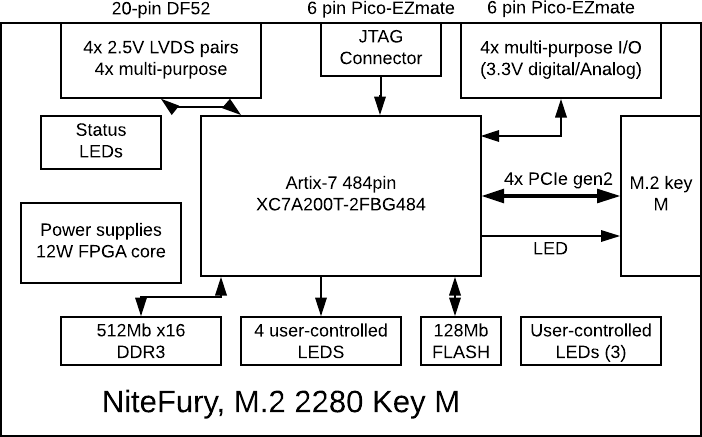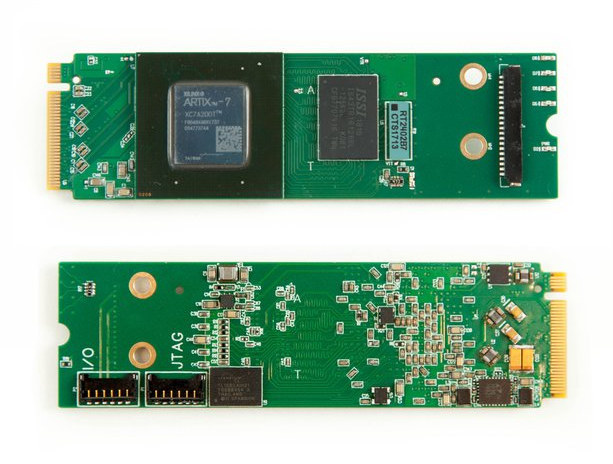NiteFury is an FPGA development board, but it works differently than most, as RHS Research LLC put a Xilinx Artix-7 FPGA into an M.2 Key M card that you can easily insert into a laptop or mini PC with a 80mm M.2 socket.
The board also includes DDR3 memory, and exposes a few configurable I/Os. You can use NiteFury to experiment with Xilinx PCIe IP, but also as FPGA co-processor for example to handle encryption, and encoding/decoding data.
- FPGA – Xilinx Artix XC7A200T-2FBG484E delivering up to ~1000 GMAC/s, with 215,360 Logic cells, 33,650 Slices, 269,200 CLB flip-flops, and 740 DSP slices.
- System Memory – 8 Gbit DDR3 (512 MB x 16)
- Host Interface – PCIe 4x gen 2 (2 Gb/s)
- External I/Os
- Via I/O connectors – 12x I/O including 4x selectable analog or digital – JTAG ready
- Via PCIe connector – 1x 3.3 V digital I/O (LED), SMBus
- Misc – 4x LEDs
- Dimensions – 80 x 22mm; M.2 (NGFF) 2280, keyed for M slot; Height: 5.5 mm without heatsink, 10 mm with heatsink

The board can be programmed using Xilinx Vivado Design Suite. The company has already published PDF schematics and sample projects in Github.
NiteFury launched on Crowd Supply earlier this month with a funding target of $17,200. The FPGA itself is said to cost over $250, but the board goes for just $320 without heatsink, and $359 with a heatsink and fan for 8W of power dissipation. Shipping is free to the US, and adds $20 to the rest of the world. NiteFury is expected to ship in August 2019. Note the company highlights that a heatsink is an absolutely necessity when using NiteFury, so if you go with the $320 reward, you’ll want to use your own cooling solution. It is also recommended to have at least 7.5 mm of clearance above the top of the board.

Jean-Luc started CNX Software in 2010 as a part-time endeavor, before quitting his job as a software engineering manager, and starting to write daily news, and reviews full time later in 2011.
Support CNX Software! Donate via cryptocurrencies, become a Patron on Patreon, or purchase goods on Amazon or Aliexpress






At the 0:11 mark — ‘Xlinix’ -> Xilinx.
That typo will be hard to correct 🙂
the fpga is compatible for ARM CPU?
I doubt the FPGA tools will work on Arm.
You could still load a bitstream from an ARM board with a compatible JTAG adapter, or use another computer to do it.